

How to Create and Use a Gantt Chart for PhD Studies

A Gantt chart is a common tool used in the project management field. It is used for schedule planning of a project and its tasks and activities. It shows the tasks, their start and end dates, and the duration needed to complete them.
A PhD is a project and may last from as few as three years to as long as six years depending on the university and department a student is enrolled in.
In order to successfully complete a PhD program, one needs to plan when each of the tasks will be completed from the word go. A Gantt chart is very useful in doing this.
A PhD student can create one comprehensive Gantt chart or several smaller Gantt charts for each of the major deliverables.
This article discusses a Gantt chart for a general PhD program that has both coursework and dissertation components.
Benefits of a Gantt chart for planning PhD studies
Steps involved in creating a gantt chart for phd studies, how to effectively use the phd gantt chart, final thoughts on the phd gantt chart.
Creating a Gantt chart at the beginning of PhD studies has the following benefits:
- It is easy to create. A student can use the traditional pen-and-paper method or existing digital tools or softwares to create a Gantt chart.
- It is easy to read. The visual presentation of the Gantt chart makes it easy for the student to read and know what is expected of him at any point in time.
- A Gantt chart makes it easy to monitor progress of PhD studies. The user can choose to use different colors for tasks that have already been completed, tasks that are close to completion, and tasks that require more time and effort to complete.
- It forms the basis for monthly, weekly, and daily planning of the PhD studies. Depending on how detailed a student wants to go in terms of planning, the Gantt chart comes in handy when writing out the monthly, weekly and even daily plans.
Step 1: List all the deliverables expected of your PhD program. In this example, the PhD program has the following requirements:
- Coursework, divided into 4 modules each lasting 2 weeks. All 4 modules need to be completed within the first year of study.
- A comprehensive written exam at the end of the fourth module.
- An oral exam once a student passes the written exam.
- Submission of a concept note.
- Submission of a research proposal once a student passes the oral exam.
- Writing a business management case study.
- Three journal papers.
- At least two conference papers.
- A dissertation.
Step 2: For each of the requirements listed above, note the start and end dates. For the above example, the PhD program lasts a minimum of 3 years and a maximum of 6 years. Assuming the minimum of 3 years (beginning January 2021), the activities’ start and end dates are as follows:
Step 3: Using the above information, create the Gantt chart using Microsoft Word, Powerpoint or Excel.
The following are useful resources for creating a Gantt chart using:
- Microsoft Powerpoint: https://www.youtube.com/watch?v=wp0vr6OkW8Y
- Microsoft Excel: https://www.youtube.com/watch?v=00s5efQWrgU&t=10s
- Microsoft Word: https://www.youtube.com/watch?v=F90RdA5X4G0
The Gantt chart created from the above data is shown below. The chart was created using Microsoft Powerpoint.

Step 4: Once the Gantt chart is complete, print it out and hang it on the wall of your study room/area. This serves as a constant reminder of the tasks that need to be done at any point in time, as well as of the progress that has been made so far.
The greatest strength in using the Gantt chart for PhD studies lies in its ability to help one plan ahead. Using the Gantt chart above as an example, the user can plan as follows:
- At the beginning of every month, look at what is required of you. For instance, the student above needs to complete module one of the coursework and at the same time start working on proposal writing.
The student can plan for module one in advance by going through the course structure and expected readings, and reading in advance before the start of the module so that he is able to follow and understand what is being taught. If there are pre- and post-module exams, the student can also prepare for them in advance.
Preliminary tasks for proposal writing can include: discussing your proposed topic with your supervisor, and searching for and quick review of literature to identify the gap that your topic will be addressing. All these can be done in the first month before the actual proposal writing starts.
- The Gantt chart can help you identify the skills that are required for the successful completion of your dissertation. For instance, the student above is expected to write a Business Management case study by June of year 2.
If the student does not have case study writing skills, he can start looking for courses that teach case study writing and complete them way before the deadline for the case study. Same case for skills such as preparing and writing a journal paper, writing a conference paper, data analysis using softwares such as Stata, SPSS, NVivo etc.
- The Gantt chart can help you plan for academic-related events such as conferences.
In the example provided above, the student is expected to attend two scientific conferences (in November of year 2 and March of year 3) and make presentations.
The student can start looking for conferences related to his field that are held during the proposed times and mark the key dates and requirements of the conferences (for instance, abstract submission deadlines, abstract submission guidelines, registration deadlines etc).
- The Gantt chart can help you create monthly and weekly plans for longer tasks such as proposal writing.
In the above sample Gantt chart, proposal writing and defense spans a period of 15 months. By March of the second year, the student is expected to defend his proposal. This may seem like such a long period of time but in reality it is not. This is because it is not the only task that the student will undertake during this period. As a result, it is easier to focus on the tasks at hand and forget about the tasks that seem to have adequate time.
Proposal writing is a daunting task and requires constant reading and updating. To ensure that the student submits his proposal in time, he can create monthly and weekly plans for the task. An example of monthly planning for the proposal writing is provided in the table below:
The monthly plan is based on assumptions, for instance, that the supervisor will review the document within the scheduled timeframe. This may or may not hold, depending on the supervisor.
It is therefore important to allow ample time for such factors that are out of your own control in order to ensure that the task is completed by the deadline.
The monthly plans can further be broken down into weekly (and even daily) plans, for instance:
- Number of papers to read per week (day).
- Number of words to write per week (day).
- How many citations and bibliographies to insert (update) every week (day).
- Number of additional articles to search and add to your library each week etc.
Each of these tasks contributes to the overall proposal writing and make the task completion easier and faster than waiting for the last few months to do it all at once.
A PhD is a medium- to long-term project depending on how long it takes to finish. It therefore requires effective and careful planning from the start of the program to ensure that each deliverable is completed within the stipulated time. The Gantt chart is an easy-to-create, and easy-to-use planning tool that can be used by all PhD students. Not only does it save the student time but it also gives him peace of mind knowing the progress of each and every task required.
Grace Njeri-Otieno
Grace Njeri-Otieno is a Kenyan, a wife, a mom, and currently a PhD student, among many other balls she juggles. She holds a Bachelors' and Masters' degrees in Economics and has more than 7 years' experience with an INGO. She was inspired to start this site so as to share the lessons learned throughout her PhD journey with other PhD students. Her vision for this site is "to become a go-to resource center for PhD students in all their spheres of learning."
Recent Content
SPSS Tutorial #11: Correlation Analysis in SPSS
In this post, I discuss what correlation is, the two most common types of correlation statistics used (Pearson and Spearman), and how to conduct correlation analysis in SPSS. What is correlation...
SPSS Tutorial #10: How to Check for Normality of Data in SPSS
The normality assumption states that the data is normally distributed. This post touches on the importance of normality of data and illustrates how to check for normality of data in SPSS. Why...

A PhD timeline for finishing quickly [Free Gantt Download]
Navigating the labyrinthine journey of a PhD program is no small feat.
From the day you step into your graduate program as a bright-eyed doctoral student, you’re immediately thrust into a complex weave of coursework, research, and milestones.
By the second year, you’ve transitioned from coursework to research, laying the groundwork for your dissertation—a pivotal component in your scholarly endeavour.
Come the third year, you face the critical oral examination, a hurdle that could make or break years of hard work.
But how does one streamline this multifaceted journey? The answer lies in a well-planned PhD timeline.
This blog serves as an invaluable guide for any PhD student looking to complete their doctoral studies efficiently, walking you through each milestone from coursework to graduation.
How to Begin with the PhD Timeline Planning?
Planning your PhD timeline is an essential first step in your PhD program.
Success in any PhD program depends, to a large extent, on effective time management and keeping track of progress through a thoughtfully crafted PhD timeline.
Start with outlining all your major requirements:
- coursework,
- dissertation,
- and the expected time needed for each task.
I also highly recommend factoring in failure time – give yourself a little bit of wiggle room for when things, invariably – go wrong.
It’s crucial to remain realistic about the time you can commit daily or weekly while keeping long-term goals in mind.
Regular check-ins on your PhD timeline and supervisor will help you stay on track and allow you to adapt if necessary.
Adjustments may be needed as you progress through your PhD program, but having a timeline as a guide can make the journey less daunting and more achievable.
Elements to include in a 3-year PhD timeline
The initial stage in this timeline typically involves coursework, often lasting one year, where the student engrosses themselves in advanced study in their chosen field.
Once the coursework is done (USA PhDs), they focus on proposing, conducting, and presenting their initial research.
By the end of the second year, most students should have a clear direction for their dissertation, a core component of the PhD process.
In this third and final year of the PhD timeline, the student focuses primarily on completing their dissertation, which involves collecting data, analyzing results, and organizing their research into a substantial, original, and cohesive document that contributes to contemporary knowledge in their field.
Regular reviews and modifications of the PhD timeline may also be necessary to accommodate various unpredictable circumstances, thus making this timeline both a guide and a flexible workplan.
It is a significant tool in successfully navigating the maze of becoming a PhD holder.
Create Your PhD Timeline for a 3 year completion
Creating a timeline for a 3-year PhD program requires careful planning, as you’ll have multiple milestones and tasks to complete.
This timeline may vary depending on your specific field, institution, or country, but here is a general outline you can use as a starting point:
Free Gantt chart excel template
Here is a free template you can modify for your own research:
Example Gantt chart for a USA PhD
Here are some common steps involved in completing a PhD, which I’ll use to create the Gantt chart:

- Orientation and Coursework (Semester 1) : Familiarization with the university, department, and coursework.
- Coursework (Semester 2) : Continued coursework and possible teaching/research assistantships.
- Select Advisor and Research Topic : Usually done towards the end of the first year or the beginning of the second year.
- Preliminary Research : Initial research and literature review.
- Complete Coursework (Semester 3) : Wrap up any remaining required courses.
- Research Proposal : Develop a full research proposal including methodology.
- Qualifying Exams : Exams to transition from a Ph.D. student to a Ph.D. candidate.
- Begin Research : Start of actual research based on the approved proposal.
- Conduct Research : Data collection, experiments, and analysis.
- Intermediate Review : A review to assess the progress of the research.
- Write Papers : Start writing papers and possibly publishing in journals.
- Finalize Research : Final experiments and data analysis.
- Write Dissertation : Writing the actual Ph.D. dissertation.
- Dissertation Defense : Defending the dissertation before the committee.
- Graduation : Completing all requirements and graduating.
Example Gantt chart for a UK, European and Australian PhD
For Ph.D. programs outside the United States, especially in Europe and some other parts of the world, students often go straight into research without the need for coursework. Here are some common steps for such programs:

- Orientation : Familiarization with the university and department.
- Select Advisor and Research Topic : Usually done at the beginning of the program.
Wrapping up
The journey to earning a PhD is complex and demanding, filled with academic milestones from coursework to research to dissertation writing.
The key to a smooth and efficient doctoral journey lies in well-planned time management—a structured PhD timeline.
This blog serves as an invaluable guide, offering detailed tips for planning out each academic year in both U.S. and international PhD programs. It emphasizes the importance of starting with an outline of major requirements and factoring in “failure time” for unforeseen challenges.
For those looking to navigate their PhD journey in three years or beyond, having a flexible but comprehensive timeline can be the compass that guides them successfully through the academic labyrinth.
Whether you’re just starting out or already deep into your research, the principles and strategies outlined here can help streamline your path to that coveted doctoral hood.

Dr Andrew Stapleton has a Masters and PhD in Chemistry from the UK and Australia. He has many years of research experience and has worked as a Postdoctoral Fellow and Associate at a number of Universities. Although having secured funding for his own research, he left academia to help others with his YouTube channel all about the inner workings of academia and how to make it work for you.
Thank you for visiting Academia Insider.
We are here to help you navigate Academia as painlessly as possible. We are supported by our readers and by visiting you are helping us earn a small amount through ads and affiliate revenue - Thank you!

2024 © Academia Insider

A Guide for Using Gantt Chart for Research Project
Are you embarking on a research project and feeling overwhelmed by the complexity of managing your tasks and timelines? Fear not! In this comprehensive guide, we will explore the power of Gantt charts for research projects. From crafting a research proposal to executing your project, Gantt charts can be your best friend. Let's dive into the world of Gantt charts and discover how they can streamline your research journey.
Understanding Gantt Charts for Research Projects
Before we delve into the practical aspects of using Gantt charts for research projects, let's start with the basics. What exactly is a Gantt chart, and how can it benefit your research endeavors?
What is a Gantt Chart?
A Gantt chart is a visual representation of a project schedule that displays tasks, their durations, and the relationships between them. This tool was originally developed by Henry L. Gantt in the 1910s, and it has since become a staple in project management across various fields, including research.
Benefits of Using Gantt Charts for Research Projects
- Clarity and Visualization: Gantt charts provide a clear and visual overview of your research project, making it easier to understand the sequence of tasks and their dependencies.
- Task Organization: You can break down your research into manageable tasks and allocate time for each one, ensuring that you stay on track.
- Timeline Management: Gantt charts help you set realistic deadlines and track your progress, preventing delays and ensuring you complete your project on time.
- Resource Allocation: You can allocate resources such as personnel, equipment, and funding to specific tasks, optimizing your research efficiency.
- Communication: Gantt charts are excellent communication tools. They allow you to share your project timeline with team members, advisors, or stakeholders, fostering transparency and collaboration.
Now that you understand the benefits of using Gantt charts for research projects , let's explore how to implement them effectively.
Creating a Gantt Chart for Your Research Proposal
Before you can dive into your research project, you'll likely need to prepare a research proposal to outline your objectives, methodology, and timeline. This is where a Gantt chart can be incredibly useful.
Step 1: Define Your Research Objectives
Begin by establishing a clear and concise delineation of your research goals and purposes.
What do you aim to achieve, and what are the key milestones? Break down your research into specific tasks or phases, such as literature review, data collection, analysis, and report writing.
Step 2: Identify Task Dependencies
Next, identify the dependencies between tasks. Certain tasks might require completion before others can commence. For instance, you might need to finish data collection before you can start data analysis. These dependencies will help you create a logical sequence for your Gantt chart.
Step 3: Estimate Task Durations
Estimate the duration of each task or phase. Be realistic in your estimates, considering factors like the complexity of the task and the resources available. It's better to overestimate than underestimate, as this will help you avoid unexpected delays.
Step 4: Create Your Gantt Chart
Now, it's time to create your Gantt chart . You can use specialized project management software like Microsoft Project, Excel, or online tools like Slikk.ai, Asana, or even dedicated Gantt chart software. In your Gantt chart, each task is represented as a horizontal bar, and the length of the bar corresponds to the task's duration. Task dependencies are indicated by the order of the bars.
Step 5: Review and Refine
Once you've created your initial Gantt chart, review it carefully. Ensure that it aligns with your research proposal and that the timeline is feasible. Make adjustments as needed.
Step 6: Share Your Proposal and Gantt Chart
Share your research proposal and Gantt chart with your advisor, committee members, or anyone involved in your project. Their feedback can be invaluable in refining your plan and ensuring its feasibility.
With your research proposal and Gantt chart in hand, you're ready to embark on your research project. But the journey doesn't end here; Gantt charts are equally essential for project execution and management.
Managing Your Research Project with Gantt Charts
As you transition from the proposal stage to the actual execution of your research project, your Gantt chart becomes a dynamic tool to keep you on track. Here's how to effectively manage your research project using Gantt charts:
Task Allocation
Assign specific tasks to yourself and your team members if applicable. Each person's responsibilities should be clearly defined in the Gantt chart. This ensures accountability and prevents confusion.
Timeline Monitoring
Regularly update your Gantt chart to reflect the progress of your project. As tasks are completed, mark them as such and adjust the timeline if necessary. If any delays occur, identify the reasons and take corrective action.
Resource Management
Keep an eye on resource allocation. Are you running low on a particular resource? Do you need to reallocate resources to meet project demands? Your Gantt chart can help you make informed decisions.
Communication and Collaboration
Share your Gantt chart with your team and stakeholders. It serves as a common reference point for everyone involved, fostering effective communication and collaboration. It's much easier to discuss project status and adjustments when you have a visual representation.
Risk Management
Identify potential risks to your project's timeline and address them proactively. If you anticipate delays or obstacles, have contingency plans in place. Your Gantt chart can include these contingencies, providing a safety net for your project.
Celebrate Milestones
As you reach important milestones in your research, take the time to celebrate your achievements. This not only boosts morale but also serves as a motivator for the next phase of your project.
Tips for Using Gantt Charts Effectively
To make the most of Gantt charts for your research project, here are some additional tips:
- Keep It Simple: While Gantt charts can become complex for large projects, strive to keep yours as simple as possible. Too much detail can make it difficult to read and maintain.
- Regular Updates: Don't let your Gantt chart become stagnant. Regularly update it to reflect the current status of your project.
- Use Colours: Use colors to differentiate tasks or highlight critical paths in your Gantt chart. This makes it easier to spot important information at a glance.
- Be Realistic: Set realistic deadlines and durations. Overloading your schedule can lead to burnout and project failure.
- Collaborative Tools: Consider using collaborative project management tools that allow multiple team members to update the Gantt chart in real time.
- Training: If you're working with a team, ensure that everyone understands how to read and update the Gantt chart. Offer training if necessary.
In the world of research projects, where meticulous planning and execution are paramount, Gantt charts are indispensable tools. They offer clarity, organization, and control over your project's timeline, making them essential for both research proposals and project management.
By following the steps outlined in this guide and implementing Gantt charts effectively, you'll be better equipped to tackle your research project with confidence. From defining your objectives to celebrating your achievements, Gantt charts are your trusty companions on the journey to research success.
So, the next time you embark on a research project, remember the power of the Gantt chart. It's not just a tool; it's your roadmap to research excellence. Happy researching!
Related articles
The future of hr: how human resources management systems are revolutionizing the workplace, managing multiple projects in your startup using slikk.ai, tracking key performance indicators (kpis) in your startup with slikk.ai, top project management software for marketing agencies in 2023, how slikk emerges as the ultimate time tracking software for agencies, one platform to boost productivity and collaboration.
Slikk helps you get more tasks done in less time. It's everything you need to work faster, communicate better, and improve productivity in a single workspace.

Thank you for visiting nature.com. You are using a browser version with limited support for CSS. To obtain the best experience, we recommend you use a more up to date browser (or turn off compatibility mode in Internet Explorer). In the meantime, to ensure continued support, we are displaying the site without styles and JavaScript.
- View all journals
- Explore content
- About the journal
- Publish with us
- Sign up for alerts
- CAREER COLUMN
- 05 December 2022
How to manage your time as a researcher
- Maya Gosztyla 0
Maya Gosztyla is a PhD student in biomedical sciences at the University of California, San Diego.
You can also search for this author in PubMed Google Scholar
It took less than two years in graduate school for me to burn out. I was spending long hours in the laboratory, yet I worried that I wasn’t making satisfactory progress. Overwork-induced exhaustion made me sloppy and impaired my productivity, creating a vicious cycle.
Access options
Access Nature and 54 other Nature Portfolio journals
Get Nature+, our best-value online-access subscription
24,99 € / 30 days
cancel any time
Subscribe to this journal
Receive 51 print issues and online access
185,98 € per year
only 3,65 € per issue
Rent or buy this article
Prices vary by article type
Prices may be subject to local taxes which are calculated during checkout
doi: https://doi.org/10.1038/d41586-022-04364-2
This is an article from the Nature Careers Community, a place for Nature readers to share their professional experiences and advice. Guest posts are encouraged .
Competing Interests
The author declares no competing interests.
Related Articles

How I harnessed media engagement to supercharge my research career
Career Column 09 APR 24

Ready or not, AI is coming to science education — and students have opinions
Career Feature 08 APR 24

How we landed job interviews for professorships straight out of our PhD programmes
Career Column 08 APR 24
Brazil’s postgraduate funding model is about rectifying past inequalities
Correspondence 09 APR 24
Declining postdoc numbers threaten the future of US life science
Husbandry Technician I
Memphis, Tennessee
St. Jude Children's Research Hospital (St. Jude)
Lead Researcher – Department of Bone Marrow Transplantation & Cellular Therapy
Researcher in the center for in vivo imaging and therapy, scientist or lead researcher (protein engineering, hematology, shengdar q. tsai lab), lead or senior researcher - flow cytometry.
Sign up for the Nature Briefing newsletter — what matters in science, free to your inbox daily.
Quick links
- Explore articles by subject
- Guide to authors
- Editorial policies

How to write a Research Proposal: Creating a Gantt chart
- Components of a research proposal
- Useful videos
- Common mistakes to avoid
- Sage Research Methods LibGuide This link opens in a new window
- Managing sources
- Request a literature search
- Research proposal - examples
- Creating a Gantt chart
- Free Apps for Research
- Academic writing
What is a Gantt chart
Some University departments require students to create a Gantt chart to represent a schedule for the research project. The Gantt chart shows the timelines of the various steps of the project including their dependencies and any resources needed . In other words, the chart depicts when an event is supposed to take place in your project by providing an outline regarding the order in which the various tasks need to be performed .
An example of a Gantt chart.

Gantt chart on Moodle
How to create a Gantt chart - videos
- << Previous: Research proposal - examples
- Next: Free Apps for Research >>
- Last Updated: Dec 19, 2023 12:35 PM
- URL: https://libguides.unisa.ac.za/research_proposal
Gantt Chart for a Research Project Proposal: Step-by-step guide

In project management, there are few tools as effective and illuminating as the Gantt chart . This simple yet powerful visual tool is invaluable for anyone overseeing a complex task, including research project proposals. It is particularly beneficial in the early stages of a project, where meticulous planning is required to ensure that all elements of the project are understood, accounted for, and scheduled appropriately. Therefore, whether you're an academic researcher, a project manager in a corporate setting, or even a student planning your thesis, understanding how to create and use a Gantt chart can be a significant asset.
What is a Gantt Chart and what is it used for?
A Gantt chart, named after its creator, Henry Gantt, an American mechanical engineer and management consultant, is a type of bar chart that visually represents a project schedule. It was first developed in the early 20th century and has since become a staple in project management across various fields and industries. Today, it's used by project managers in sectors like construction, software development, research and development, and more.
At its core, a Gantt chart consists of two main components: tasks and time. The tasks related to the project are listed on the vertical axis, while the horizontal axis represents time. Each task is represented by a horizontal bar, the length of which corresponds to the duration of the task.
Make your own Gantt chart in Gleek .
Gantt charts are incredibly useful for planning and scheduling projects, tracking progress, and managing dependencies between tasks. They provide a clear visualization of the project timeline and help to identify potential bottlenecks and overlaps. This makes them an ideal tool for coordinating teams, allocating resources, and keeping stakeholders informed.
The versatility of Gantt charts solves numerous problems faced by project managers. They simplify complex projects by breaking them down into manageable tasks and visualizing their sequence and duration. This can help in avoiding over-scheduling, underestimating deadlines, and mismanaging resources.
Whether you're a seasoned project manager or a student working on a research proposal, mastering the use of Gantt charts can significantly streamline your project planning process and enhance your team's productivity.
Components needed for Research project proposal diagram
Creating an effective research project proposal diagram requires several key components. These elements provide a comprehensive overview of the project, including its timeline, tasks, and significant milestones.
Project Stages: Each stage of your research project should be clearly defined. This can include the literature review, methodology development, data collection and analysis, results compilation, proposal drafting, peer review, and final edits.
Timeline: The timeline provides a visual representation of the project's duration. It should outline the start and end dates of the project, as well as the estimated completion time for each stage.
Tasks: Each task within the project stages should be clearly outlined. This includes what needs to be done, who is responsible for it, and when it should be completed.
Milestones: Milestones mark significant achievements or phases in your project. These can help track progress and ensure that the project is moving forward as planned.
Dependencies: Dependencies show the relationship between different tasks. It's crucial to highlight how the delay in one task can impact others.
Status: The status of each task and stage helps monitor the project's progress. It can indicate whether a stage is completed, in progress, or yet to start.
Notes/Comments: Any additional information, observations, or feedback about the project can be included here. This could be insights gained during the research, changes made to the project plan, or issues that have arisen.
By incorporating these components into your diagram, you can create a well-structured, transparent, and efficient project proposal.
Creating a Research project proposal Gantt chart using the Gleek App
Step 1: launching gleek and selecting 'new diagram'.
First, launch Gleek.io in your web browser. Once you're in, select 'New Diagram' from the options available. In the diagram type, choose 'Gantt'.
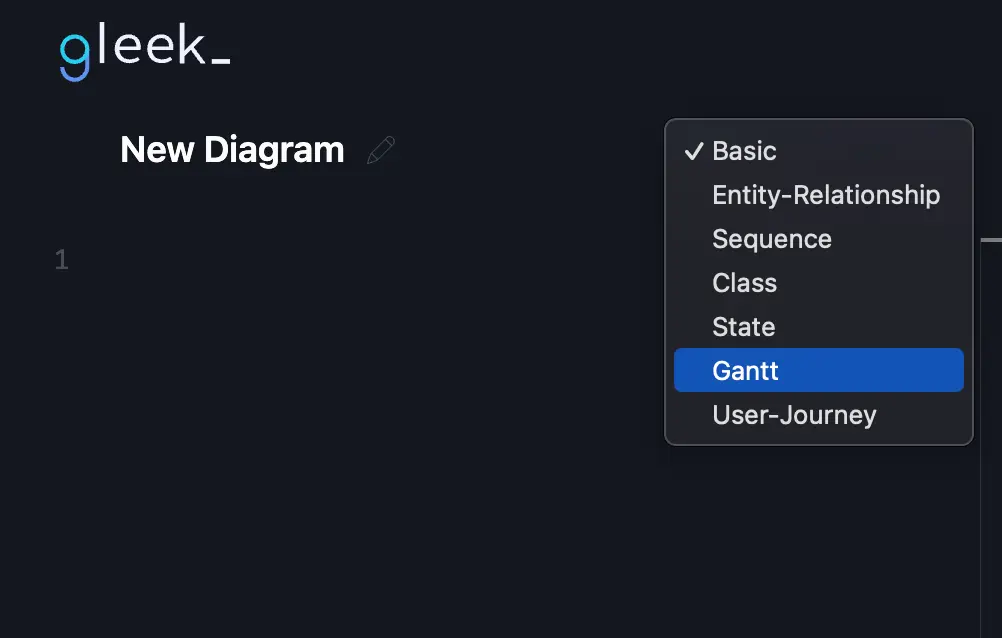
Step 2: Defining Research Goals
The research project initiates with an active phase dedicated to defining research goals, which commenced on December 15, 2023, lasting for a week. This phase involves brainstorming, outlining objectives, and establishing the research's overarching scope.

Step 3: Literature Review Phase
Transitioning to the next stage, we have the completed 'Literature Review' phase spanning two weeks. This phase entails an in-depth analysis, sourcing relevant publications, synthesizing existing knowledge, and aligning it with the predefined research goals.
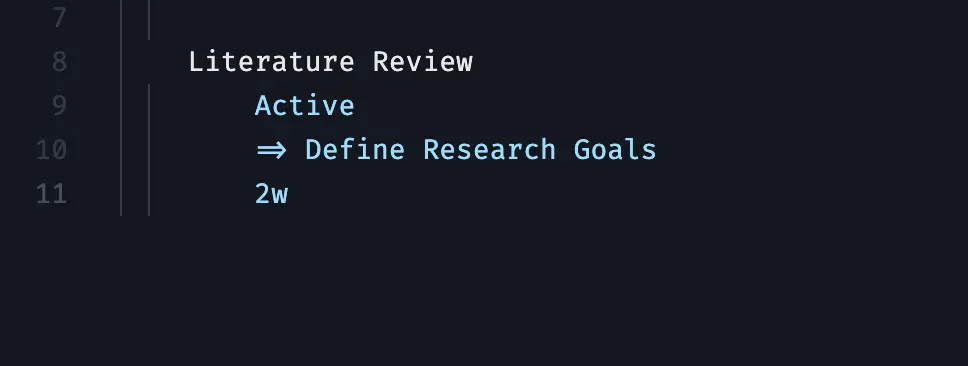
Step 4: Methodology Design Phase
Progressing to the 'Methodology Design' phase, currently active for three weeks, this stage intricately structures the research approach. It involves designing methodologies, frameworks, and strategies based on insights gleaned from the literature review, ensuring a robust research plan.

Step 5: Data Collection Phase
Following the planning stages is the critical 'Data Collection' phase, slated for four weeks. This phase involves meticulously gathering and assembling primary data, employing various methodologies such as surveys, experiments, or interviews, aligning with the established research framework.
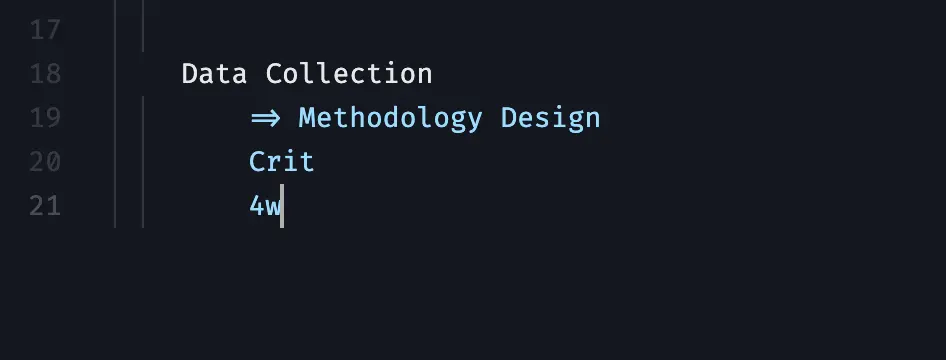
Step 6: Data Analysis Phase
Post-data collection, the active 'Data Analysis' phase spans three weeks. This phase engages in thorough data examination, statistical analysis, and deriving insights from the accumulated information. It involves identifying patterns, correlations, or trends relevant to the research objectives.

Step 7: Results Compilation Phase
Subsequently, the 'Results Compilation' phase consolidates and organizes the analyzed data over two weeks, presenting it in a coherent format. This phase involves preparing comprehensive reports, graphs, or summaries, showcasing the findings derived from the data analysis stage.
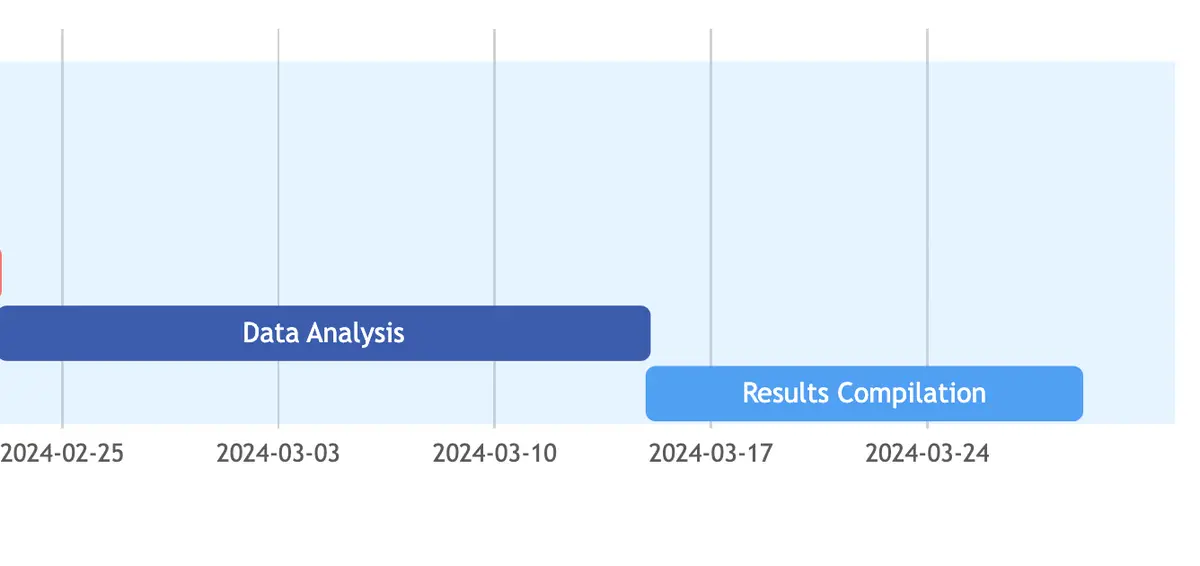
Step 8: Drafting Proposal Phase
Advancing further, the active 'Drafting Proposal' phase, extending over three weeks, involves crafting the research proposal. It includes outlining the research problem, detailing methodologies, and structuring a cohesive proposal aligned with the project's objectives.
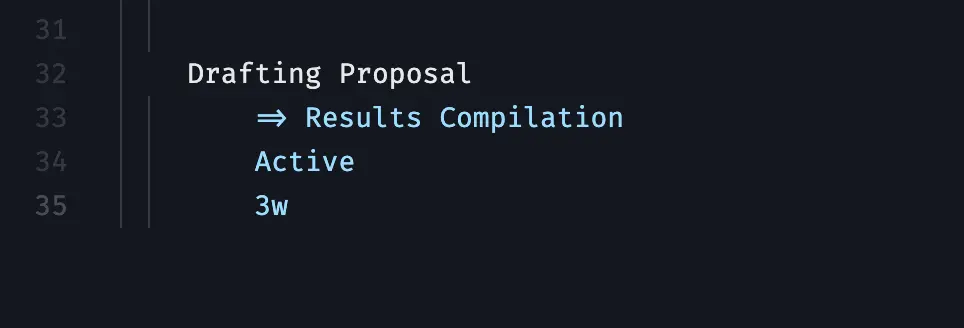
Step 9: Peer Review Phase
Upon completion of the draft, the two-week 'Peer Review' phase gathers insights and constructive feedback from peers or subject experts. It involves peer evaluations, discussions, and recommendations aimed at refining and enhancing the proposal's quality.
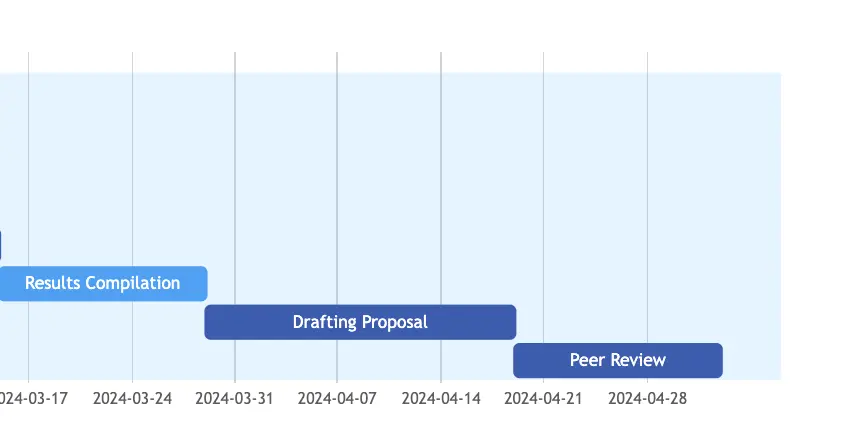
Step 10: Final Edits
Finally, the one-week active 'Final Edits' phase focuses on meticulous revisions, addressing feedback, and ensuring the proposal's completeness, accuracy, and compliance with set standards. This stage includes proofreading, formatting, and polishing the final document.

Step 11: Proposal Submission Milestone
The 'Proposal Submission' milestone, set for May 15, 2024, marks the conclusive stage, signifying the submission of the crafted and refined research proposal for evaluation and potential implementation.
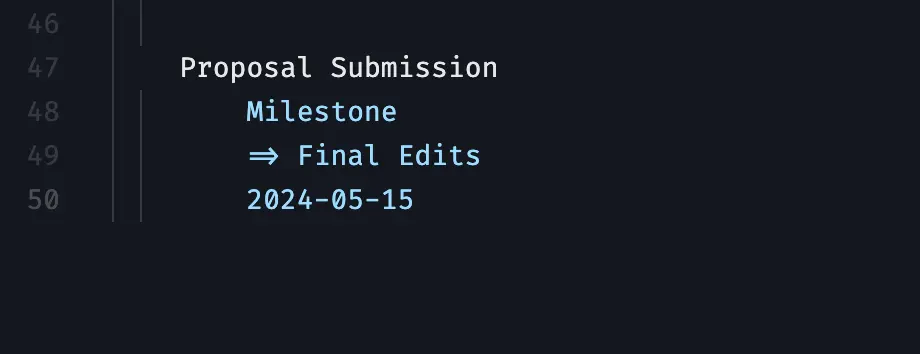
Hurray, You Did It!
And there you have it! Your Research Project Proposal Gantt Chart is now complete.

This comprehensive diagram, with its clearly defined stages, tasks, timeline, dependencies, resources, and status, provides a holistic view of your research project. It not only serves as a visual representation of the entire project but also acts as a roadmap guiding you from the initial brainstorming phase to the final proposal submission. Utilizing such a diagram can greatly enhance your project planning and execution, ensuring all aspects are considered, dependencies are taken into account, and milestones are tracked. It fosters better coordination, communication, and understanding among team members, leading to more efficient and effective project management.
About Gleek.io
Gleek.io is a powerful tool that can further enrich your project planning needs. It's an intuitive app designed to help you visualize complex ideas, processes, and systems through various types of diagrams. Whether you need to create a flowchart, UML diagram, or even a Gantt chart like the one we've just built, Gleek.io makes the process straightforward and hassle-free.
With its keyboard-centric approach, Gleek.io allows you to create diagrams faster than traditional drag-and-drop tools. You can quickly jot down your ideas and see them evolve into structured diagrams in real-time, making it an ideal tool for brainstorming sessions, project planning, and presentations.
In conclusion, Gleek.io is more than just a diagramming tool. It's a platform that enables you to visualize your thoughts, communicate complex ideas simply, and manage your projects more effectively. Give it a try for your next project and experience the difference it can make!
Related posts
Beyond Traditional Planning: Top Gantt Chart Alternatives in 2024
Gantt chart critical path explained
Pert vs. Gantt Charts: Choosing your project's blueprint
back to all posts
Get started
- Project management
- CRM and Sales
- Work management
- Product development life cycle
- Comparisons
- Construction management
- monday.com updates
How to use a Gantt chart for a research project
Using a Gantt chart for a research project can give all stakeholders a better understanding of timelines and the resources needed for each task. With all project activities neatly laid out within a timeline and every minor detail accounted for, a Gantt chart provides your team with the framework for successful project operations.
In this article, we’ll discuss a Gantt chart and how you can use it in a research project to maximize efficiency and promote greater transparency. We’ll also share how you can use monday.com’s project management Work OS to simplify the management of any research project further.
What is a Gantt chart?
A Gantt chart is a bar chart popularized in the early 1900s by Henry Gantt. It lets you establish a detailed project plan according to when you need each task completed.
If done correctly, a Gantt chart creates a realistic time frame for a project by establishing a start date for the whole project and each task. Then, you can pair these start dates with an estimation of how long the task will take, broken down by days, weeks, or months.
What makes a Gantt chart unique is that it establishes dependency relationships between all relevant tasks, which can help you better understand necessary workflows.
For example, let’s say you’re creating a research proposal. One of your tasks is to promote awareness and garner support for the proposal on social media. However, before you can do that, you need to create informational materials you can distribute and have the proposal outline ready for viewing. Since these necessities are clearly outlined in the Gantt chart, you can plan your project timeline accordingly.
How can you use a Gantt for research projects?
Research projects are vast undertakings that require a lot of your time, effort, and brain power. Sometimes it’s easy to get sidetracked or confused about what comes next in your research or how you should put it together.
A clear understanding of objectives and deadlines can help you organize even the most complex research project undertakings. Even better, a Gantt chart provides clear step-by-step instructions with dependency relationships marked to ensure every team member understands their responsibilities.
A Gantt chart ensures all research project team members clearly understand objectives, deadlines, and task dependency relationships.
Best practices for planning and scheduling a research project
Understanding the best practices for planning and scheduling a research project can help you get the most out of your Gantt chart . A few best practices include:
- Have a clear goal : Before sitting down to plan your research project, ask yourself some crucial questions. What are you trying to achieve? Why are you trying to achieve it? When do you need to complete it?
- Use scheduling tools : Use task and resource scheduling tools when possible to reduce the risk of human error.
- Get the team involved : Gather your team together for a brainstorming session, if possible, when developing a list of tasks required to meet your final objective.
- Consider dependency relationships : Consider the dependency relationships between objectives carefully and be realistic about time frames. Ensuring your team has enough time to successfully and thoroughly complete each task from the beginning sets your research project up for success.
- Identify potential issues : Identify risks and potential roadblocks in your schedule and have a backup plan for each to ensure a steady workflow with minimal pushbacks.
- Consider resource requirements : Consider the resources necessary to complete each task. Remember to include work hours as resources and schedule each team member appropriately to achieve objectives in the desired time frame.
- Plan for reporting : Assign specific times, or interval periods, for progress reports and compare these with your initial estimations. If these reports show alterations are necessary, don’t be afraid to make changes.
- Identify KPIs : Before the research project begins, identify key performance metrics and track them as you go to define your success clearly. You may find using a relevant tool or platform the easiest way to track performance metrics.
Having the right tools can increase efficiency, decrease downtime, and ensure objective deadlines are not only met but exceeded.
Managing research projects on monday.com
monday.com’s robust project management Work OS makes managing research projects easier by:
- Centralizing projects from start to finish : Our Work OS lets you centralize all projects from conception to completion, with customizable dashboards that show you the information you deem most important. Quickly assess risks, bottlenecks, and roadblocks to keep your research project moving forward.
- Streamlining project workflows : Streamline workflows by automating routine tasks and assigning teammates to the work they’re most qualified for. Then, track individual and project-wide progress in real-time with regular task updates. Use color coding to make task management even more straightforward.
- Enabling communication across teams : Our Work OS promotes communication between project members and across different teams, so all stakeholders know where things stand at all times. You can share documents, leave notes, and work together in real-time for more effective communication that allows you to exceed every deadline and meet every objective.
monday.com can provide your team with a Gantt chart view to make project management easier. Get started with monday.com’s powerful Work OS by building a research project workflow from scratch or try a few of our other templates for managing research projects easier.
Related templates
A basic Gantt chart can help you plan your research project in detail. On monday.com, you can add a Gantt View to any type of project board. Below are some of our recommended templates from our Template Center that you can use to fine-tune other essential aspects of your research project.
Keyword power tools template
Our Research Power Tools Template uses a Gantt chart format to help you visualize project timelines, manage project resources, and monitor each phase of your research projects from one platform.
Publication and journals template
Our Publications and Journals Template is an excellent tool for content publishing companies. You can use our template to:
- Manage your publication process: Our template enables whole-process management from submission to approval. Easily track article status and monitor writer workload to ensure you meet publishing deadlines.
- Visualize your publishing pipeline: Customizable dashboards allow you to receive a high-level overview of all current and upcoming articles and where they stand.
- Track individual contributions: Ensure each writer meets minimum contributions and isn’t given too large a workload by tracking individual contributions.
By now, you should have a working idea of Gantt charts and how they increase transparency and efficiency in project management. However, if you still have questions, we’ve answered a few FAQs below.

How do you create a dissertation in a Gantt chart?
To create a Gantt chart for a dissertation, you should first understand your timeline and deliverables. Once you’ve written these down, create detailed task lists of how you’ll accomplish each deliverable and consider dependency relationships between each. Finally, use the Gantt chart to outline your dissertation from start to finish.
What should be in a dissertation timeline?
In a dissertation timeline, you should include the following:
- Role assigning (if applicable)
- Research tasks
- Experiments, social or scientific (if applicable)
- Data collection and analysis
- First draft completion
- Submission to the advisor (first) and dean (at completion)
How do you create a Gantt chart in Word?
You can create a Gantt chart in Microsoft Word by:
- Opening a new Word document
- Change the document orientation from vertical to horizontal
- Insert a bar graph into your document
- Make format alterations as necessary to make the graph look like a Gantt chart
- Insert information and customize as necessary
Any team can increase transparency in their research projects with monday.com
Using a Gantt chart to create a detailed project timeline can help increase transparency and promote greater efficiency in your organization’s research projects.
When you pair a Gantt chart with monday.com’s robust project management system, you have the tools you need to meet deadlines, complete objectives, and exceed expectations.
Send this article to someone who’d like it.
How to develop an awesome PhD timeline step-by-step
A successful PhD journey begins with a solid plan that includes a PhD timeline . A thought-through and well-designed PhD timeline requires some time but can be accomplished in a few simple steps.
Why a clear PhD research timeline matters
Step 1: decide what to include in your phd timeline, step 2: discuss your provisional phd timeline with your supervisor/s, step 3: design your phd timeline, step 4: regularly update your phd timeline.
Doing a PhD means committing to a challenging project that spans several years. Therefore, it is no surprise that doing a PhD can feel quite overwhelming. How do you even begin to tackle such a huge project?
A PhD timeline breaks down the daunting task of doing a PhD into an actionable plan with tasks and milestones along the way.
Even if not everything will go as planned (which is normal and no problem!), a PhD timeline can give PhD students peace of mind. A good plan, worked out in a PhD timeline, helps them to structure their time, communicate their goals and work toward specific targets.
Some PhD students are required to create a PhD timeline as part of their programme. Yet, even if PhD students are not required to do so, it is highly recommended to create a PhD timeline!
PhD timelines should be as diverse as PhD research projects: What you decide to include in your timeline should fit to your situation, goals and your programmes’ requirements.
Common elements included in a PhD timeline are the following:
- Data collection : How, when and where are you collecting your research data?
- Fieldwork : Is your data collection spread out or are you spending several weeks doing fieldwork? If so, when is this scheduled and how can you avoid overlaps with other requirements, such as coursework?
- Experiments : Are you running experiments for your PhD research? If so, when? And how long do you estimate this will take you?
- Data analysis : Once you have your data, be it quantitative or qualitative data, when and how do you analyse it? How much time do you block for this task?
- Writing plan : When are you writing down your results? How can you break down writing into different parts, for instance, writing goals per chapter or article?
- Publications : Publication requirements differ from PhD programme to programme. Even if you write your PhD as a monograph (instead of a selection of articles) , you should try to publish something during your PhD. When would you have an opportunity to do so, and how much time does it require?
- Conferences : Every PhD student should present at a conference during their PhD trajectory. Which conferences are you interested in? When do they take place, and when would you have findings to share at a conference?
- Coursework : What are your PhD programme’s coursework requirements? What courses are you interested in, and when are they offered?
- Other activities : Are there any other activities that are crucial for your PhD project? Think, for instance, about an extensive dissemination campaign, collaboration with external partners, internships, online activities etcetera.
Make a draft plan, including dates and times. Then move to Step 2: Discussing it with your supervisor/s!
Proactively creating your PhD timeline is a good step as a PhD student. However, you should share your thoughts and ideas with your PhD supervisor/s and get their input.
If possible, set up a meeting with your supervisor/s that is entirely dedicated to your PhD timeline. During this meeting, you can share what you created so far.
Then, you should discuss the following questions:
- Is there anything missing in the PhD timeline?
- Is the PhD timeline realistic?
- Should anything be removed from the PhD timeline to prioritise other tasks?
- Does the PhD timeline meet all the formal requirements to graduate within the designated amount of time?
- Is there institutional support and sufficient financial resources for activities such as fieldwork, conference attendance, etcetera?
Make sure to take notes during the meeting, as you will need the answers to these questions to edit your provisional PhD timeline.
Not only will this discussion help you to finalise your PhD timeline. It will also help you to get clarity on your supervisor/s’ expectations!
You may also like: Planning your PhD research: A 3-year PhD timeline example
Following the input of your supervisor/s, your PhD timeline will reach a more final stage. Now it is time to think about designing your PhD timeline:
A well-designed PhD timeline is not just pretty for the eyes, but it makes it much easier to have a good overview of all plans and milestones ahead.
Yet, it would be wrong to argue that there is a one-size-fits all solution to designing a perfect PhD timeline.
Maybe you are a very visual person and would prefer your timeline to illustrate a broad overview of the upcoming years. Maybe you are encouraged by checking things off your to-do list. In that case, a more detailed PhD timeline with many different tasks and milestones may be more suitable for you.
A common way to design PhD timelines is via Gantt charts. If you want to learn more about Gantt charts for your PhD timeline, check out my post on how to design Gantt charts in Microsoft Excel, Power Point and Word.
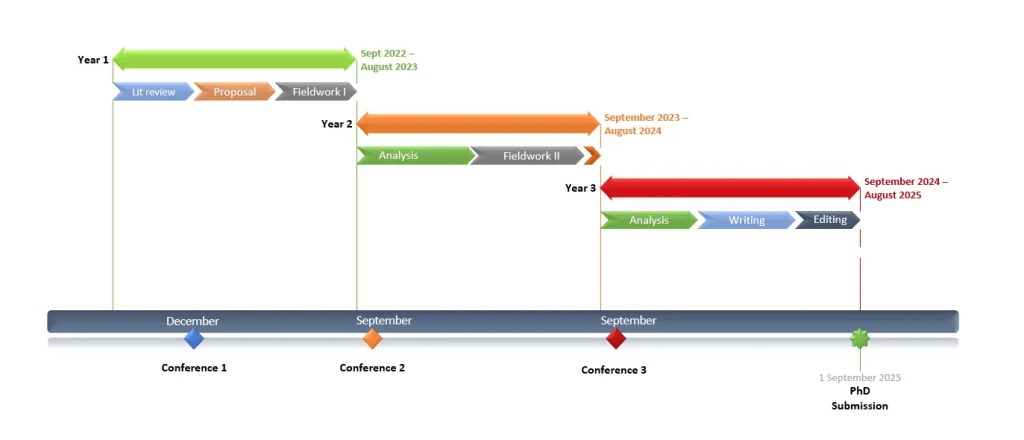
A PhD timeline is there to keep you on track and to showcase the milestones that you reached in your journey so far. However, while it is good to have a solid plan, the future is impossible to predict.
Your PhD timeline should be a living document or chart. Update it regularly!
For instance, a conference may be cancelled. You may have a period of sick leave. An experiment may not work out as planned. Or writing a paper takes longer than expected.
Successful PhD students remain flexible and don’t panic as soon as something does not work out as planned.
So, use your PhD timeline to regularly reflect on your progress and your current situation. Update your PhD timeline when needed, to prioritise tasks and set more concrete and achievable goals for the upcoming months.
Get new content delivered directly to your inbox!
Subscribe and receive Master Academia's quarterly newsletter.
Left your dissertation too late? Ways to take action now
The best email signatures for graduate students (with examples), related articles.

How to paraphrase a quote: 4 simple strategies

Revise and resubmit: Sample peer review comments and examples

13 great academic phrases to write your discussion (+ published examples)

Introduce yourself in a PhD interview (4 simple steps + examples)
- How it works
Dissertation Gantt Chart – A Visual Way to Track your Dissertation Progress
Published by Ellie Cross at January 26th, 2023 , Revised On October 9, 2023
A dissertation Gantt chart is an essential tool for any student completing a doctoral degree. The chart helps you to organise and track your progress, ensuring that you complete your dissertation on time and with the required quality.
The Chart Includes the Following Key Elements:
- Title of the Dissertation
- Target Date for Completion
- Estimated Time to Complete (ETC)
- Actual Time to Complete (ACT)
- Changes Made to ETC or ACT from the Original Plan
- Summary of Major Accomplishments or Difficulties encountered during the project
Features of Gantt Chart
The following are the key features of a dissertation Gantt Chart:
- It has a timeline that shows the progress of the project.
- It contains tasks and deadlines for each phase of the project.
- It allows you to track resources and costs associated with the project.
- It provides an overview of how much work remains to be done in each project phase.
- It can help you to make informed decisions about when to take specific actions on the project.
How to Create a Custom Dissertation Gantt Chart?
When writing a dissertation , it is important to keep track of the progress and deadlines. One way to do this is to create a Gantt Chart. This guide will show you how to make a Gantt Chart for your dissertation.
- Decide what tasks need to be completed and when they need to be completed. The goal is to have everything on the chart in order by the deadline.
- Start by creating a table or graph to represent your project’s timeline. This will help you to easily see where tasks are located and how much time they will take.
- Next, add in each task’s duration (in hours and minutes), as well as the associated resources that will be needed for completion (e.g., research materials, software).
- Finally, allocate specific days and times for each step of your project based on the information in your timeline table. This will help you stay organised and on track!
- Assign each task a colour based on its importance. For example, green tasks should take less than an hour, and blue tasks should take more than an hour but at most two hours.
Gantt Chart Templates
There are many different Gantt Chart templates available online, so choosing one that best suits your needs is important.
Some popular templates include the Pareto chart and the Venn diagram. Both of these charts offer a variety of options for customisation, so you can create charts that look exactly the way you want them to. Additionally, both charts can easily be converted into graphs using GraphPad Prism.
If simplicity is key, then the line graph may be a better option. This chart offers minimal customisation options but allows you to clearly see trends and patterns in your data.
Hire an Expert Writer
Orders completed by our expert writers are
- Formally drafted in an academic style
- Free Amendments and 100% Plagiarism Free – or your money back!
- 100% Confidential and Timely Delivery!
- Free anti-plagiarism report
- Appreciated by thousands of clients. Check client reviews

The Importance of the Gantt Chart
Gantt charts are valuable as a student, and even if you are a university graduate, they can help you. Along with making good grades, as recommended by the university, you have to strive to take full advantage of the use of your projects. Brainstorming with your classmates can be a productive way to accomplish this objective. You need to use Gantt charts for your projects for several reasons.
It Helps Provide a Visual Outlook
A Gantt chart helps you handle your workflow by providing a detailed graphical representation. Gantt charts allow you to see all the tasks that must be completed, the amount of time needed, and task overlap. This will allow you to keep better track of goals and deadlines, which will be useful in ensuring you are on time to complete everything.
Solve Challenges Easily
A Gantt chart allows you to determine even better how to avoid issues and get the job done faster. You can see the result of the tasks that have been completed if you want to perceive the resources rightly to make the project run smoothly and quickly.
Evaluate Time
Effective task planning with the Gantt chart will help you organise and finish the projects efficiently. In addition, it will make it easier to see the actions you must complete before beginning others.
Ease of Communication
The Gantt chart will help you keep your group and sponsors notified of the modifications to your timetable. That’s why it’s crucial to have a regular update if your schedule changes. This means you can even use and provide available resources effectively.
Oversee a Project
The Gantt chart is crucial to the success of a project because that is how it assists in directing its activities through scheduling, assigning, and monitoring tasks. The horizontal chart makes it easy to see the projects’ progressions. You also always get to know what’s happening within any ongoing tasks.
Ease your Brain’s Memory
Gantt charts can help you reclaim your mind space by easing the selection of content you need to remember. Then, all you have to do is focus on accomplishing and acting on your current priorities. Team members can also see the course of the project’s tasks.
Reduces Cost
A Gantt chart is beneficial if you want to cut down on costs. Equipped with this, you can appreciate the tasks that have been carried out and stay up to date on what needs to be completed. As a result, you will remember essential deadlines and thus save more money on expenses.
The Benefits of Using a Dissertation Gantt Chart
No one knows the feeling of sitting in front of a blank whiteboard, trying to figure out how to write a dissertation . The process can seem daunting and overwhelming, but using a Gantt Chart can make the entire process much easier.
A Gantt Chart is simply a chart that helps you plan and track your tasks. It can be used for any project but is especially helpful when writing a dissertation. You can track your progress by breaking down your work into specific dates and tasks.
You will be able to see exactly where you are in progress. A Gantt Chart can provide a visual representation of your progress, which can help motivate you to complete your work on time.
Do you lack time and want someone to write your dissertation for you? Do you want to save money on your dissertation? Are you looking for someone to help with the grant chart process? Check out ResearchProspect! They can help you find the perfect person to create your dissertation.
You can trust these professionals to deliver top-notch work. Moreover, they offer affordable rates and a range of customisation options. So if you’re looking for an affordable and reliable writing service, look no further than ResearchProspect.
Frequently Asked Questions
What is dissertation gantt chart.
A dissertation Gantt Chart is a visual timeline or project management tool that outlines key research tasks, deadlines, and dependencies to help plan, track, and manage the progress of a dissertation project efficiently.
You May Also Like
What are the key factors influencing language development and what can do to accelerate the process of language acquisition? Here is all you need to know!
Not familiar with how to proofread and edit your dissertation? Find out the best tips and do’s and don’ts of proofreading and editing a dissertation here.
USEFUL LINKS
LEARNING RESOURCES

COMPANY DETAILS

- How It Works
- Undergraduate courses
- Postgraduate courses
- Foundation courses
- Apprenticeships
- Part-time and short courses
- Apply undergraduate
- Apply postgraduate
Search for a course
Search by course name, subject, and more
- Undergraduate
- Postgraduate
- (suspended) - Available in Clearing Not available in Clearing location-sign UCAS
Fees and funding
- Tuition fees
- Scholarships
- Funding your studies
- Student finance
- Cost of living support
Why study at Kent
Student life.
- Careers and employability
- Student support and wellbeing
- Our locations
- Placements and internships
- Year abroad
- Student stories
- Schools and colleges
- International
- International students
- Your country
- Applicant FAQs
- International scholarships
- University of Kent International College
- Campus Tours
- Applicant Events
- Postgraduate events
- Maps and directions
- Research strengths
- Research centres
- Research impact
Research institutes
- Durrell Institute of Conservation and Ecology
- Institute of Cyber Security for Society
- Institute of Cultural and Creative Industries
- Institute of Health, Social Care and Wellbeing
Research students
- Graduate and Researcher College
- Research degrees
- Find a supervisor
- How to apply
Popular searches
- Visits and Open Days
- Jobs and vacancies
- Accommodation
- Student guide
- Library and IT
- Partner with us
- Student Guide
- Student Help
- Health & wellbeing
- Student voice
- Living at Kent
- Careers & volunteering
- Diversity at Kent
- Finance & funding
- Life after graduation
Research projects & dissertations
Managing a research project.
The following guide has been created for you by the Student Learning Advisory Service . For more detailed guidance and to speak to one of our advisers, please book an appointment or join one of our workshops . Alternatively, have a look at our SkillBuilder skills videos.
The stages of a research project
The basic stages involved in undertaking a university research project are as follows:
1. Choose your research area
Usually, it is best choose an area that you have already studied or are studying within your academic field. Not only will this help you identify potential research, but you can be confident in finding a suitable supervisor and reliable sources within the university. Choosing an area that you also find particularly interesting will help sustain your engagement.
2. Conduct preliminary research (scope out the topic)
Survey current research surrounding your chosen subject area. Reflect on it carefully, and take advice from academic staff to establish what has already been written on your chosen subject area. This will enable you to identify what you can do that has not been done before.
3. Decide your research topic
Clearly define and delineate your research topic. The more clearly you do so the more confidence and clarity you will have in what you are trying to achieve, and the easier it will be for you to monitor your progress. If you’re uncertain what you’re trying to achieve, how will you know whether you’re on course or not?
At this stage you might also formulate a provisional research question – that is, the question your research will answer:
Research topic: Investigate ‘A’ and ‘B’ to see if/how they interrelate.
Research Question: ‘To what extent is A caused by B?’
4. Decide your methodology
As you are deciding your topic, you should be investigating and considering your research methodology – how you will conduct your research. Is it going to be experimental, observational, theoretical, textual, qualitative, quantitative? Will it involve human subjects? Are there ethical considerations – specific protocols, procedures or approaches to follow? Think about the research method you have chosen; what advantages does it give? What insights might it yield? What difficulties might it pose? How has it been used before in your field of study?
5. Submit/present your research proposal for approval
Most schools have a formal deadline for receiving research proposals/dissertation plans, and a formal approval process. In some cases this is an assessment stage – so make sure you know exactly what you need to submit, and when, in order to progress with your project. Your school will have given you guidance about what your proposal should include. Generally, the common elements are:
- Your main research question/problem/title
- Questions or concerns that will help you solve your main research problem
- A brief literature review or list of key texts/sources
- An overview of your methodology
- A timeline showing your main research project tasks
6. Finalise your topic and methodology
You may need to revise your research plan in the light of feedback you receive during the approval process. Many students are overambitious in their aims; academic staff have a much clearer idea of what is achievable and necessary in terms of a successful research project, so be guided by their advice. You may also need to modify your methodology in the light of your initial research, or a pilot study. It may be necessary, for example, to alter a questionnaire that isn’t generating the data you were expecting.
7. Conduct your research (fieldwork)
This might take place in a laboratory, in a library or archive, at a computer, on the streets or in a field. Whatever the location, this is the practical activity of collecting raw information or data. Be aware that what you think you are going to find out, and what you actually do find out, can often be very different, so be prepared to alter your research aims/question accordingly.
8. Analysis/data processing
Whatever your research topic, you will need to analyse and process the information you have collected in order to make sense of it. This might involve statistical analysis, generating graphs, charts or tables, organising information into categories, or critical appraisal of texts or events. As well as finding out something, you need to understand what it means within your academic field.
9. Writing up
This is the process of producing the written document – your dissertation or thesis – upon which your research project will be assessed. Allow enough time to improve and revise your work through a series of drafts, and to edit and proof-read the final document – including ensuring that any graphs/images referred to in the text are properly numbered and labelled, and that your referencing is error-free – before formatting and binding the finished document. Do not underestimate how long the writing up process will take.
10. Submission
All academic research projects are time constrained, so you will have a specific deadline for submitting your work. With longer research projects, you will also have intermediate deadlines (e.g. progress/upgrade boards). Consequently, you will need to time-manage each stage of your work to ensure that you complete the overall project on time.
Project managing your research
Any complex project involving multiple activities and deadlines requires some form of management. Using simple project management techniques will allow you to keep control of your research project – to schedule your work more effectively, to identify how much time you have to spend on each stage, to create intermediate milestones that will tell you if you’re on schedule or not (and allow you to respond accordingly) and give you a clear overview of your progress.
One simple but highly effective technique is to produce a Gantt chart. This provides you with a clear visual plan of your research project, based on scheduling the different stages involved against a time base. The example below (Figure 1) is based on the ten basic research project stages, scheduled against two (hypothetical) formal deadlines – submission of the proposal in week 10 and submission of the finished dissertation in week 24:
Figure 1: Simple research project Gantt chart
This example is typical of an undergraduate or taught Masters’ dissertation. Longer research projects (PhD, Masters by research, etc.) will generally have more activities spread over a longer timeframe (See below, Figure 2, for an example of a project plan for a humanities PhD).
Figure 2: Humanities PhD example Gantt chart
In project management, the scheduling of individual activities is always worked backwards from the deadline. Thus, the amount of time that you have to complete each task is a function of the overall project schedule. As shown above, some tasks have to be carried out consecutively (i.e., you can’t start the next task until you’ve completed the previous one), but other tasks can be carried out at the same time, or started before the previous task has been completed, (e.g. you might be able to start analysing your data whilst you’re still collecting it). What you also need to bear in mind with undergraduate dissertations is that your research project constitutes only one part (25%) of your academic activities, and that you’ll be working on other assignments, reading, exam revision, etc, at the same time. As such, it is important that you make full use of the available time period and balance your priorities accordingly.
Tip: With longer-term projects such as these, it can be difficult to stay focused and motivated. Try to dedicate some time to your project every day/week (depending on your other academic commitments) and break your tasks down into smaller chunks so that they are more manageable. The Pomodoro technique can also be helpful for generating small bursts of concentration. If you are struggling, maybe read an article on your topic to remind yourself of your interest in the area, or talk to fellow students or your supervisor(s).

A Definite Research Process for PhD- What Students Should Know?
“PhD/doctoral research is a process driven by sample collection, wet and dry lab work and data collection. It’s important for students to know the step-wise process of PhD research. Let’s understand the various steps in research.”
“Research–” the word has crucial importance in academics. Hence, the paramount level of the academic field is a research-driven process that is awarded to someone for achieving new knowledge.
I am talking about the PhD, which people often call a “doctorate” which is the honor and prestige in any education system. Every subject and interdisciplinary field is now eligible for PhD, which was only awarded to a few in a few subjects in history.
The fortune– right now is that anyone can apply for a PhD and can enroll but unfortunately that all can’t get it and meanwhile stuck. The biggest reason behind it is that they don’t know the exact “process of research.”
It’s understandable and convincing, after all, they (and you) are only students, students who just got their masters a couple of months or a year ago. It is indeed the university’s or guide’s responsibility to let them know about how to do research.
Research is a systematic process from selecting a purpose to getting output as data. As I said, students fail to understand that and so fail miserably in their doctorates. Although, if you are on this article, you landed on the right page.
In this article, I will explain to you the process of research for PhD in a stepwise manner so that you can understand how to do it. Trust me, it’s gonna be fun and you will learn a decent thing. Stay tuned.
Related article: What is PhD?- History, Definition, Origin, Requirement, Fees, Duration and Process .
Steps in the PhD Research Process
The research process for PhD is a systematic investigation that starts with a definite purpose and ends with significant and important data. Let’s dig into understanding starting with steps.
Keep in mind that we are elaborately explaining the process of research, not the process and steps of getting or doing PhD.
- Select the research topic
- Propose the research- aims, objective and purpose
- Postulate the scope of the study
- Wet and dry lab work proportion
- Define the methodology for the topic
- Collecting requirements
Sampling
- Doing systematic investigation
- Collecting data
- Interpreting data
Diagram of the research process
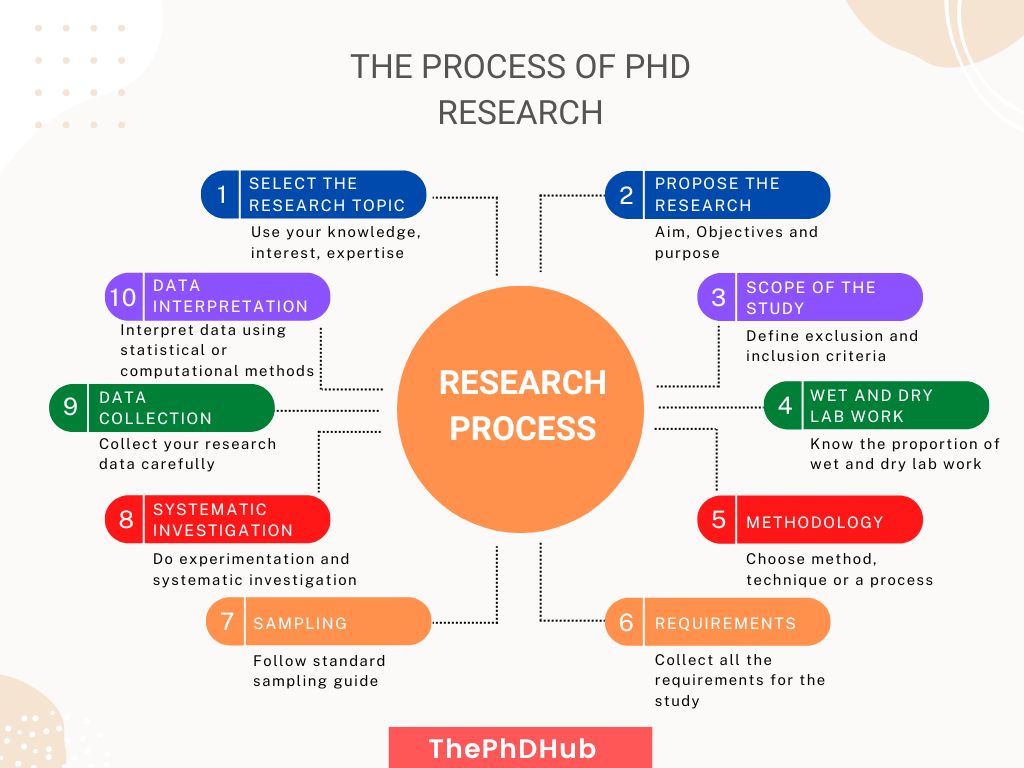
PhD Research Process:
Select a research topic.
Most students don’t think so, but research topic selection is a crucial step in crafting the research for your PhD. If you made a mistake at this stage, you will have to suffer a lot during your entire journey.
Keep in note that you can not change your topic, which would be your thesis title later on, anytime and it’s a lengthy and hard process. So be careful what to choose. However, let me tell you that it isn’t that hard, actually.
Using your present knowledge, your expertise, experience— if any, interest and most importantly your guide’s knowledge you can select a research topic . When you search for any topic, make sure to test it on these parameters.
Another important point is that ‘read’. Read as much literature as you can. Read literature, by keeping in mind what output the original researchers are getting. Do an assessment of whether the results are rare, easy to achieve, most common or lengthy to get.
Get an expert’s help, and ask your senior, co-guide or other scientists about your selection. Discuss the pros and cons of the topic you have chosen.
Propose the research
Now it’s time to propose your research by stating the aim, objectives and purpose. The research must be purposeful to fill the knowledge/ research gap . The sole purpose here is to achieve different/separate milestones while heading to your “Aim.”
Most importantly the purpose of your research should solve some problem for a society, a group of people or mankind. Prepare an excellent research proposal , afterward.
The scope of the study
It’s paramount to set boundaries. Let me tell you the bitter truth that your chances of defending your thesis successfully depend on how you set your boundaries— means the scope.
Postulate the scope of the study— the inclusion and exclusion criteria for your research, the sample size and the conditions of research. However, note that the scopes should not be too small and that can’t justify your work.
Wet and dry lab work proportion
Next, you have to first understand the exact proportion of wet and dry lab work you have to do. Wet lab work is research is done in a laboratory while dry lab work is research is done in a system or computer lab– the simple and straightforward meaning.
What are the consequences if the proportion isn’t balanced?
See, if you are a lab person– more a technical fellow, and if you have to do a lot of computational, statistical and mathematical analysis, you can’t deliver strong results. Vice versa, computational analytics personnel can’t do a lot of wet lab work.
In each condition, the researcher would be stuck. So better to know how much wet and dry lab work needs to be done.
Define methodology
Yet another critical parameter that directly impacts your ‘defense chances’ is the methodology. The methodology is a process, collection of techniques or system you have chosen to defend your research topic.
They get or do not get results because they have selected this method. We get or do not get results because we have selected that method.
These two simple sentences show the importance of the methodology and how it affects your thesis defense . Again, methodology sets some boundaries for your research and eventually gives you the power to chase.
Select a methodology in which you have the knowledge, experience and sheer expertise. It must be in the range of your topic. Keep these things in mind for methodology selection.
- The importance of the selected methodology for your topic
- The availability of the methodology at your place
- The difficulty level
- The accuracy of the methodology
- Sensitivity and specificity of the methodology
- The cost of methodology
Collecting requirements
Now everything is nearly done for your research, you are just one step ahead to start doing actual research. You have to–- in the next step, order and collect the requirement to conduct the research. For example, chemicals, glassware, plasticware, or anything else which is required.
In the next step, you have to start doing research by initiating the sampling process. One more time, you have to read and document many things related to sampling. You have to take care of sampling technique, time, transportation, consent— if required, and ethical approval— if required.
Remember, if you are dealing with human, animal or biological samples, you have to need an expert, prior permissions and transportation facilities for the sample. Do take care of all these things.
Systematic investigations
You have selected a methodology, and collected utilities and samples. Now, you can start systematic investigations, meaning– actual experimentation. Do experiments, set up your working SOP and optimize the protocols or process.
Start experimenting with samples only when you get tentative results in the optimization part. You can club sample processing if you have the expertise or do single experiments with each sample.
Note down the changes, optimization, process and experiments you perform every day. Don’t forget to note down every minute results.
Data collection
A crucial part of everyday research is data collection. Note down, and take pictures or videos of the results you get. Along with that note down the results– something unusual, different or pattern you observed.
Data interpretation
The interpretation segment is also significant and must be handed over to the expert– meaning your guide. However, if someone has a deep knowledge of the subject, just like me can perform the interpretation part too.
To interpret the data various computational, and mathematical and statistical analysis has been performed– For example, Mean, Median, Mode, P and student tests are some of the common and popular statistical analyses.
For some crucial research— tools like bioinformatics and other computational analysis are also performed. The final results should be in numbers, figures or something quantifiable, in most cases.
PhD research process Flowchart
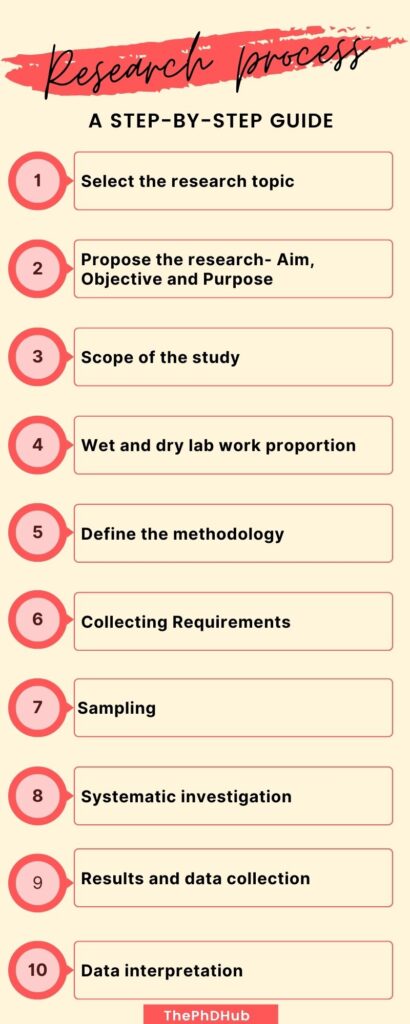
Wrapping up:
This is a broad overview of the steps in the PhD research process. I know everyone knows how to do research, but knowing the exact pattern would certainly help to understand it at a micro-level.
When you learn things at such a micro level, your chances of getting success increase. I hope this article makes sense for, at least newbie fellows who have just entered the world of uncertainty— the PhD.
Why is this important? Let me tell you, these steps of research you can use to prepare your GANTT chart for research and monitor your every research goal. Want to know about the GANTT chart? Read this article.

Dr. Tushar Chauhan is a Scientist, Blogger and Scientific-writer. He has completed PhD in Genetics. Dr. Chauhan is a PhD coach and tutor.
Share this:

- Share on Facebook
- Share on Twitter
- Share on Pinterest
- Share on Linkedin
- Share via Email
About The Author

Dr Tushar Chauhan
Related posts.

How to Prepare Actionable PhD Research Plan Template

What are Research- Aim, Objectives, Tasks/Goals? [Our System]
Leave a comment cancel reply.
Your email address will not be published. Required fields are marked *
Save my name, email, and website in this browser for the next time I comment.
Notify me of follow-up comments by email.
Notify me of new posts by email.

IMAGES
VIDEO
COMMENTS
Steps involved in creating a Gantt chart for PhD studies. Step 1: List all the deliverables expected of your PhD program. In this example, the PhD program has the following requirements: Coursework, divided into 4 modules each lasting 2 weeks. All 4 modules need to be completed within the first year of study.
Manually creating a PhD timeline Gantt chart in PowerPoint is a bit easier than in Excel. Therefore, I will explain the process here. First, you need to open a blank PowerPoint slide. Then click on Insert (1.), then Chart (2.). A popup will appear.
Free Gantt chart excel template. Here is a free template you can modify for your own research: Gantt-chart-template-FREE Download. Example Gantt chart for a USA PhD. Here are some common steps involved in completing a PhD, which I'll use to create the Gantt chart: ... Research Proposal: Develop a full research proposal including methodology.
The image of 36 months GANTT chart plan for a PhD. PhD GANTT chart for research . Research has been such a crucial parameter in PhD. Every research starts with sample collection and ends with data collection. The stepwise process of PhD research included many other important steps. One trait of research is 'uncertainty'.
A screenshot of an ideal GANTT chart. You can prepare a month-wise planning, individual semester-wise planning and goal-wise planning etc. I will explain these things in upcoming articles on 5 different types of GANTT charts for PhD. Custom writing services: If you find difficulties in preparing a research plan, synopsis, proposal or GANTT chart.
Optimizing the Use of Gantt Charts. To maximize the benefits of using Gantt charts in academic research, consider the following tips: Regular Monitoring and Updating: Keep the Gantt chart updated with the latest information on task progress, deadlines, or unforeseen challenges. This will ensure that the Gantt chart accurately represents the ...
How to Propose/Report PhD Research progress with Gantt Charts! #GanttChart #PhDProductivity #PhDTips (long title)MANAGE PHD PROJECTS WITH GANTT CHARTS | In t...
Hi! This is my first ever video and I talk about one of my favourite planning tools: The Gantt Chart! This is an introductory video and I made this as an aid...
Do you use a Gantt chart for your PhD studies? If not, watch this video to learn why you should create one and how to use it for effective management of your...
Plan and monitor your PhD with a Gantt chart and include all of your activities in implementing Open Science practices to ensure efficiency and societal impact of your research work and efforts. This Gantt chart provides you with an example and template plan for your Ph.D. from thesis proposal writing to the thesis defense. Live spreadsheet ...
Step 4: Create Your Gantt Chart. Now, it's time to create your Gantt chart. You can use specialized project management software like Microsoft Project, Excel, or online tools like Slikk.ai, Asana, or even dedicated Gantt chart software. In your Gantt chart, each task is represented as a horizontal bar, and the length of the bar corresponds to ...
Example: Planning year 2 of a 3-year PhD. Maria completed her first round of data collection according to plan, and starts the second year of her PhD with a lot of material. In her second year, she will focus on turning this data into two journal articles. Months 1-2: Maria works on her data analysis.
I created a Gantt chart shortly after joining my PhD lab, and update it a few times per year. It includes timelines for key experiments, major conferences, milestones for my doctoral programme and ...
Some University departments require students to create a Gantt chart to represent a schedule for the research project. The Gantt chart shows the timelines of the various steps of the project including their dependencies and any resources needed.In other words, the chart depicts when an event is supposed to take place in your project by providing an outline regarding the order in which the ...
At its core, a Gantt chart consists of two main components: tasks and time. The tasks related to the project are listed on the vertical axis, while the horizontal axis represents time. Each task is represented by a horizontal bar, the length of which corresponds to the duration of the task. Make your own Gantt chart in Gleek.
You can create a Gantt chart in Microsoft Word by: Opening a new Word document. Change the document orientation from vertical to horizontal. Insert a bar graph into your document. Make format alterations as necessary to make the graph look like a Gantt chart. Insert information and customize as necessary.
Why a clear PhD research timeline matters. Step 1: Decide what to include in your PhD timeline. Step 2: Discuss your provisional PhD timeline with your supervisor/s. Step 3: Design your PhD timeline. Step 4: Regularly update your PhD timeline.
DOI: 10.21428/51e64700.e51360d0. Plan and monitor your PhD with a Gantt chart and include all of your activities in implementing Open Science practices to ensure efficiency and societal impact of ...
The Gantt chart is an aid, the real goal is the learning, planning and reflection. So, next time you hear the 'build a Gantt chart advice'. Know that the Gantt chart is not the goal, the ...
A Gantt chart helps you handle your workflow by providing a detailed graphical representation. Gantt charts allow you to see all the tasks that must be completed, the amount of time needed, and task overlap. This will allow you to keep better track of goals and deadlines, which will be useful in ensuring you are on time to complete everything.
Figure 1: Simple research project Gantt chart This example is typical of an undergraduate or taught Masters' dissertation. Longer research projects (PhD, Masters by research, etc.) will generally have more activities spread over a longer timeframe (See below, Figure 2, for an example of a project plan for a humanities PhD).
In this section, I am enlisting and explaining 10 possible amazing benefits of PhD GANTT chart. Mandatory for PhD. Organize your tasks. Divide your work. Prepares timeline for each task. Monitor the progress. Your stand on PhD. Boost confidence.
The research process for PhD is a systematic investigation that starts with a definite purpose and ends with significant and important data. Let's dig into understanding starting with steps. Keep in mind that we are elaborately explaining the process of research, not the process and steps of getting or doing PhD. Select the research topic.